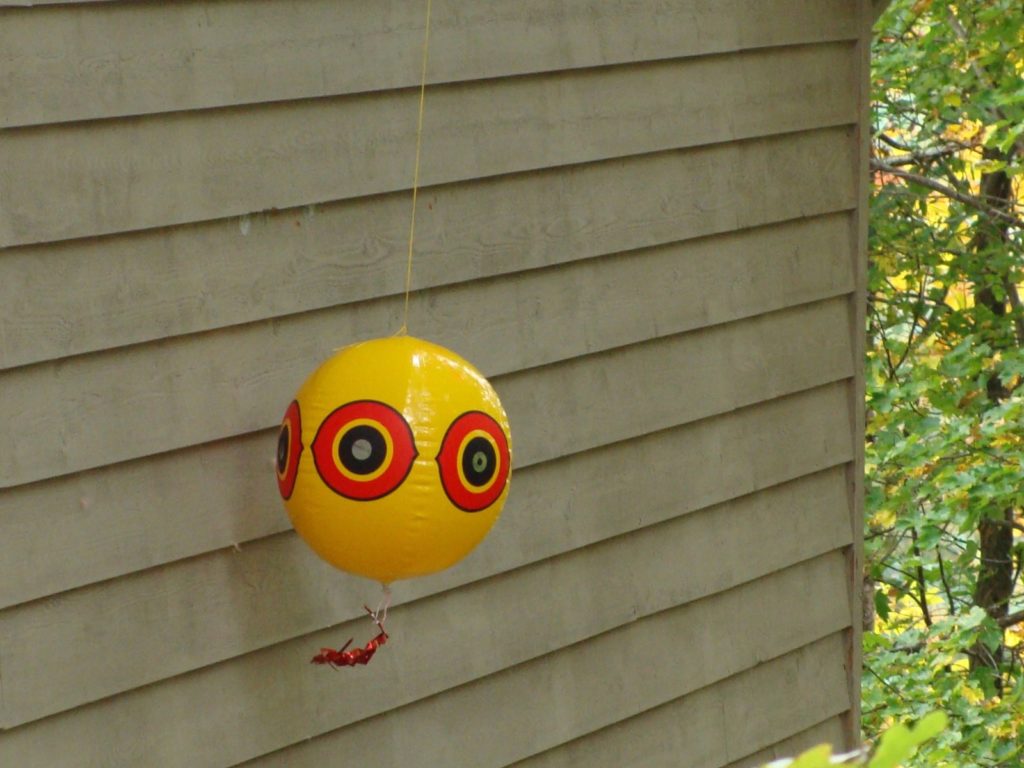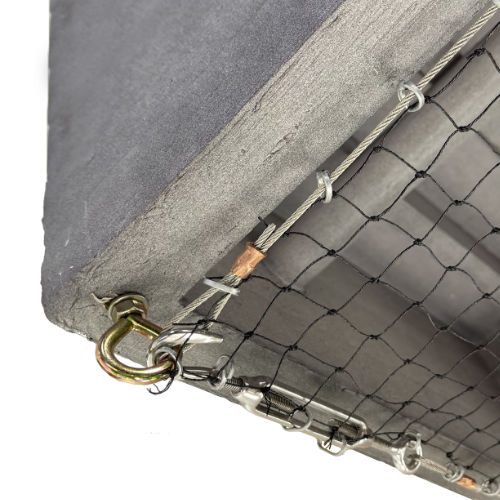Woodpecker Control

There are over 200 different species of woodpeckers worldwide, and approximately 23 of those can be found in the United States. Installing the right woodpecker control products can prevent major property damage to your home or business. Woodpeckers are in the family of Picidae, which is included in the order Piciformes. Woodpeckers drill holes in trees and buildings to excavate nesting holes, find or store food, and to attract mates. Woodpeckers peck on all kinds of building materials, including cedar siding. Once the pecking starts, you’ve got to act fast and choose the right bird deterrents and repellents to get rid of pest woodpeckers
Woodpecker control can be tricky because this species is protected under the federal Migratory Bird Treaty Act as well as under state law in many areas. If you have a woodpecker problem, quickly implement short term solutions such as reflective tape or other types of reflective scare products that reflect light. All of these are available from Bird Barrier. Remove any bird feeders that may be an attraction. Then contact Bird Barrier for a long term solution that will keep your home or business safe.
Whether you are a bird control professional or a homeowner grappling with a woodpecker problem, Bird Barrier is here to help. We offer a variety of effective, humane woodpecker repellents and deterrents that will help you get rid of woodpeckers that are causing property damage.
Learn how to get rid of woodpeckers using the one-two punch of Optical Gel and The Intimidator visual bird deterrents.
Woodpecker Products

Buy Optical Gel™ to Stop Woodpeckers from Nesting and Sounding
Optical Gel is a multi-sensory bird repellent that deters birds using sight, smell and touch.

Buy Visual Bird Deterrents™ to Deter Woodpeckers from a Distance
Decoy owls and other predators, reflective and holographic devices such as scare tape (not aluminum foil), Optical Gel, our bright colors of bird scare eye balloons, fly away lasers, and other visual deterrents keep pest birds away.

Buy StealthNet® to Block Woodpeckers from Structures
The strongest, most versatile bird exclusion system. StealthNet denies birds access to any architecture.Effective Products to Stop Woodpeckers in Their Tracks
With the right woodpecker deterrent products and techniques, professional installers and property owners can prevent further damage by getting rid of woodpeckers. At Bird Barrier, we’re here to help you find the right approach to the specific woodpecker problems at a site. For most situations, the most effective woodpecker repellent solutions include:
• Audio/Visual Control Products for Repelling Woodpeckers from Open Spaces
A multi-sensory bird deterrent that is installed on vertical surfaces to deter woodpeckers from the building. Install one dish above and one below any woodpecker hole found on a structure. Pest birds typically leave immediately and rarely return after Optical Gel applications.
Optical Gel repels birds safely by offending their senses of smell, touch, and sight. The product smells like peppermint, which birds hate. It repels them visually by putting off ultraviolet light that appears to birds as flame or smoke (even though we humans cannot see it). If the woodpecker gets close enough to touch Optical Gel it will be repelled by the stickiness (woodpeckers don’t like their feet touching sticky substances).
Placing dishes of Optical Gel above and below a woodpecker hole will deter even the most determined bird from causing additional damage. Using Optical Gel at every woodpecker hole on a structure, can get rid of the birds completely. Once the woodpeckers are gone, make sure to use wood putty to fill the holes and then paint over them.
Wind chimes, simple reflective tape, and aluminum foil aren’t enough to frighten off pest woodpeckers. Instead use woodpecker deterrents that use flashing lights, moving objects, and shapes that resemble natural dangers. To effectively deter woodpeckers, devices that are designed to scare away woodpeckers should be hung as close as possible to the spot where they are drilling holes.
Loud noises frighten woodpeckers away and if used correctly and consistently, may get rid of pest birds completely. Audio deterrents emit loud noises, woodpecker distress calls, or predator calls that signal danger to woodpeckers.
Woodpeckers that have established a site as their home territory will be much harder to scare off. Visual and audio frightening devices must be installed as soon as a woodpecker problem begins in order to be effective. If the woodpecker is territorial and persists in returning despite the audio or visual scare device, another control method, such as bird netting will need to be installed to effectively remove the pest bird from the site.
• Bird Netting Products Exclude Woodpeckers from Enclosed Areas
Bird netting is the most effective woodpecker deterrent. Total exclusion controls pest woodpeckers! The most effective woodpecker control product for keeping the birds out of buildings, barns, sheds, wooden structures, and other enclosed spaces is StealthNet® Bird Netting. Install ¾” StealthNet to create an impenetrable barrier that will keep woodpeckers away from a structure. Leave the bird netting in place long enough to permanently modify the pest woodpecker’s behavior.
StealthNet is one of the best woodpecker deterrents available for protecting wood siding (even underneath the eaves of a home – a common way that woodpeckers can cause damage to your home). Bird netting is a nearly invisible and totally humane solution for woodpecker problems.
If you have tried other methods of woodpecker deterrents and continue to see damage from returning birds, StealthNet is the ultimate solution. Installing bird netting from roof edge to the ground is the most effective way to prevent woodpeckers from making contact with a structure. If a property owner does not wish to install StealthNet across the entire structure, we recommend the use of Optical Gel.
• How to Use Our Woodpecker Deterrent Products
If you need expert guidance when choosing woodpecker pest control products, Bird Barrier’s expert staff is here to help. Give us a call or send us an email to learn more about our woodpecker repellents and deterrents. We can also refer you to a pest control company in your local area that specializes in woodpecker pest control services. We’ll provide customized support on how to plan, order, and install any bird control system we offer.
Installers, we offer bird control training classes and installation videos that will help you solve your clients woodpecker problems and other issues with avian pests.
Woodpecker Drumming & Drilling Behavior
Audio and visual scarers deter woodpeckers from damaging a site by signaling danger. This type of woodpecker deterrent is most effective if installed immediately after woodpeckers start drumming. Here are descriptions of these bird control devices and how they can be used to scare off woodpeckers:
Woodpeckers typically drum for one of the following reasons:
- The drumming sound is used to attract a mate.
- They are digging a hole to build a nest in.
- They are digging a holes looking for wood boring insects to eat.
Most woodpecker problems happen during woodpecker breeding season, which happens in early spring. Sometime in the months between February through June (depending on your local climate) woodpeckers will begin drilling nesting and roosting cavities. Most of the damage you’ll see during the springtime mating season will be caused by only one or two woodpeckers.
Woodpecker Identification
- 7 to 15 inches in length.
- Usually have brightly contrasting coloration.
- Most males have some red on the head.
- Many species have some black and white marks.
- Short legs.
- Two sharp-claws on two front-facing long toes.
- A single backward-facing pointed toe.
- Stiff tail feathers that serve as a supportive prop.
Woodpecker Habitat, Diet, Nesting, and Breeding Patterns
- Habitat · The woodpecker is most commonly found in wooded regions of the country, where they can cause damage to the exterior of wooden buildings and houses. The woodpecker’s body is designed to thrive in a woodland habitat—they can easily cling to tree trunks and branches while pecking for food (which is unfortunately why they are so good at clinging to wood siding, telephone poles, and other structures to which they commonly cause damage).
- Diet · Woodpeckers primarily feed on tree living or wood-boring insects using their strong beak and long tongue to dislodge food. Some members of the woodpecker family (Flickers) feed on insects of the ground, while others prefer food sources that provide native berries, fruits, and nuts.
- Nesting · Because they require trees for food and shelter, woodpeckers select nesting sites near wooded regions. These birds use their strong beak to bore holes into tree limbs or trunks when carving out a place to live. They prefer to live in dead trees and show a tendency to build on the side of the structure that receives the early morning light and warmth from the rising sun. The loss of old growth trees has accelerated their use of manmade structures for homes, such as wooden fence posts, utility poles, and buildings.
- Breeding Patterns · Woodpeckers breed in the spring, commonly laying 2 to 8 dull white or glossy eggs. The incubation period lasts from 11 to 14 days and maybe longer for larger woodpeckers. They typically have 2 broods per year with some species bearing eggs 3 times per year. Eggs are watched over by both parents during incubation.
- Migratory Patterns · Very few species of woodpeckers are migratory, although some show movement southward in winter. Other species of woodpecker have been known to migrate from higher elevations in the mountains to warmer lower valleys when the weather turns cold. However, for most woodpeckers, cold weather is not a problem because of the availability of their food supply under bark or in dead or rotted wood where it is out of reach of most birds.
Woodpecker Products

Buy Optical Gel™ to Stop Woodpeckers from Nesting and Sounding
Optical Gel is a multi-sensory bird repellent that deters birds using sight, smell and touch.

Buy Visual Bird Deterrents™ to Deter Woodpeckers from a Distance
Decoy owls and other predators, reflective and holographic devices such as scare tape (not aluminum foil), Optical Gel, our bright colors of bird scare eye balloons, fly away lasers, and other visual deterrents keep pest birds away.



